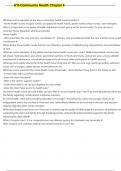ATI-Community Health Chapter 4
What are some examples of the ways community health nurses practice?-
: Home health nurses, hospice nurses, occupational health nurses, parish nurses,school nurses, case managers
Why is it important to be aware of health disparities of each group within acommunity?: So you can try to
minimize those disparities whenever possible
Home health:
-Who prescribes the care and who coordinates it?: -Primary care providerprescribes the care and the nurse usuall
coordinates it
What do the home health nurses function as?: Educator, provider of skillednursing interventions, and coordinator
of care
What are some examples of the skilled services home health nurses pro- vide?: Skilled assessment, wound care,
lab draws, med education and admin, parenteral nutrition, IV fluids and meds, central line care, urinary catheter
insertionand maintenance, coordination/supervision of various other participants in health services
What are some safety checks the home health nurse must look at?: Non-se-cure rugs, electrical outlets, extension
cords, use of oxygen, safety devices in the bathroom, etc.
What are some questions the home health nurse should ask?: -Does theclient have food in the house to eat?
-Is there help with household activities?
-Does the client live alone?
-Who is the client's support system?
-Is the client able to set up and dispense his own meds?
-Does the client have access to health care?
Do home health nurses provide foll0w-up care after an acute hospital stay?: Yes! They must educate the client and
the family regarding complications oradverse reactions
In home health, what does providing education encourage?: Providing edu-cation encourages clients to be
independent and to be involved in their own care. Italso allows families to be involved in the care and decision-
making regarding their family members
What does hospice care focus on?: It focuses on enhancing the quality of lifethrough the provision of palliative care
supporting the client and family through thedying process, and providing bereavement support to the family
following the client'sdeath
What is hospice care?: It is a comprehensive care delivery system for clientswho are terminally ill.
Does hospice care continue medical care aimed towards a cure?: No
, ATI-Community Health Chapter 4
What type of care does this describe?
"The focus becomes relief of pain and suffering, as well as enhancing qualityof life.": Hospice care
Is hospice care only provided for the client?: No, it's for the client and theclient's entire family
Is controlling symptoms a priority of hospice care?: Yes
What is the purpose of health care in the workplace?: It seeks to bothpromote health and prevent occupational
illness and injury
What happens from improvement and maintenance of health at the work-place?: Workplace expenditures are
decreased by less sick time use, fewer workerscompensation claims, and decreased use of group health coverage
What are some things that occupational health nurses do?: Develop part- nerships with workplace admin, industria
hygienists, safety specialists, occupationalmedicine physicians, HR departments, union representatives, and health
insuranceagencies
In assessing risk for work-related illness and injury, the nurse should keepin mind the following factors affecting
susceptibility to illness and injury?: - Host factors
Agent factors Environmental factors
How do host factors affect susceptibility to illness and injury in occupa- tional health?: Worker characteristics such
as job inexperience, age, and pregnan-cy
How do agent factors affect susceptibility to illness and injury in occupa-tional health?: -Biological agents (viruses,
bacteria, fungi, blood-borne, airborne pathogens)
-Chemical agents (asbestos, smoke)
-Mechanical agents (musculoskeletal or other strains from repetitive motions, poorworkstation-worker firth, lifting
heavy loads)
-Physical agents (temp extremes, vibrations, noise, radiation, lighting)
-Psychological agents (threats to psychological or social well-being resulting inwork-related stress, burnout,
violence)
How do environmental factors affect susceptibility to illness and injury inoccupational health?: -Physical factors
(heat, odor, ventilation, pollution)
-Social factors (sanitation, overcrowding)
-Psychological factors (addictions, stress)
Examples of primary prevention in occupational health?: Teaching good nutrition and knowledge of health hazards
and providing info on immunizations, anduse of protective equipment




